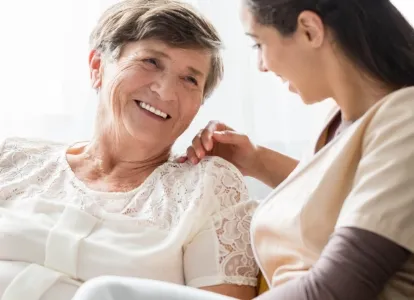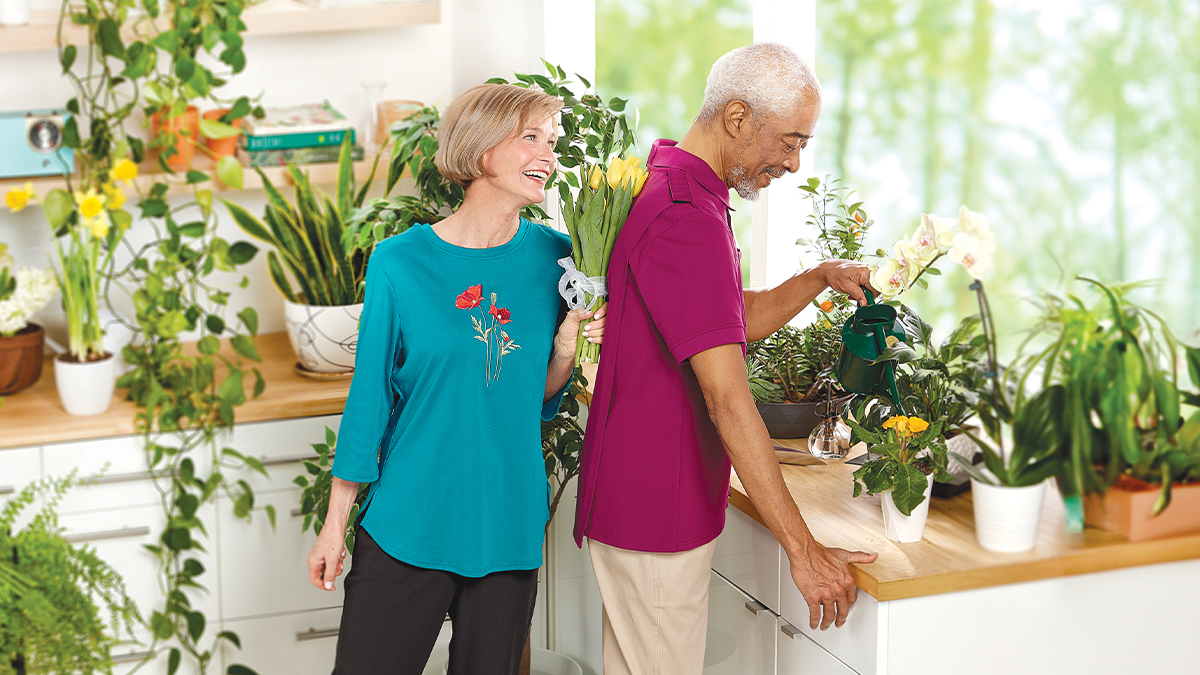6 Physical Activities for Older Adults to Increase Independence
Regular physical activity is one of the most important things we can do to maintain muscle strength and mobility as we age. Moderate daily physical activity promotes healthy aging, aids in disease prevention such as heart disease, and can help maintain independent living through healthy living.
Not all exercises have to be a vigorous activity. From flexibility exercises to muscle strengthening activities, there’s various ways for older adults to get their bodies moving.
Follow this guide to learn how the health benefits of physical activity for older adults can lead to increased independence and a healthier lifestyle.
What to Consider Before Starting New Physical Activities
Assessing Fitness Levels and Health Conditions
Before beginning any new exercise program, you should assess your physical health. Ask your doctor or other healthcare provider if there are physical activity guidelines pertaining to your medical history and general physical health. Certain health conditions, such as regular chest pain or dizziness, should be assessed before beginning to work out.
Taking note of your physical health level and concerns will help you find your appropriate exercise routine.
Proper fitness attire is also important to consider before you exercise. Make sure to choose clothing that is not overly baggy so that you can move freely, such as these pants for senior ladies and adaptive men’s pants from Silverts.
Wearing proper footwear for physical activity can help reduce injuries and reduce fall risk, such as footwear for older women and sneakers for older men from Silverts.
Setting Realistic Goals
Setting realistic fitness goals will help you stay motivated and goal-oriented. Creating short-term and long-term goals can help you more easily accomplish your goals, which is rewarding.
For example, a short-term fitness goal can be: I will walk for five minutes tomorrow. A long-term goal can be: By the end of the month I will walk for 20 minutes without stopping.
Whether you are a seasoned athlete who engages in vigorous-intensity aerobic activity or is an aging adult who has decided to begin exercising for healthy aging, maintaining regular physical activity that meets your mental health and physical needs is the priority.
Consulting with Healthcare Providers
Some physical health concerns may affect your physical activity ability. Your doctor and other healthcare providers will be able to help assess your overall physical health and recommend certain activities based on your personal needs. They may also advise against certain activities due to health concerns.
If you have arthritis, for example, your healthcare provider may recommend low impact aerobic activities and certain strength-building activities as well, while reducing impact on your joints.
After you begin regular exercise, remember to assess how your body feels. If you notice new pain or soreness, it is a good idea to visit your healthcare provider.
6 Physical Activities Suitable for Older Adults
Activity 1: Walking – Benefits and Tips
Walking is one of the best activities someone of any age can do. Walking is considered a moderate physical activity that is low impact and involves the entire body.
Whether you are speed walking or taking a nice weekend stroll, this physical activity requires stamina, balance, strength, and even flexibility, which will lead to improved well-being.
Regardless of your physical activity level, heel-toe-walking is an exercise that can be enjoyed from beginner through expert level. Discover the best walking shoes for seniors with slip-on and Velcro features to make it easier for older people to dress.
Activity 2: Water Aerobics – Why It’s Ideal for Seniors
Maintaining and building muscle mass is especially important as we age. Muscle strengthening activity helps increase your independence by reducing the need to rely on others for daily tasks, such as carrying groceries into your house.
Water aerobics is ideal for seniors because the water makes your body buoyant which will reduce injury from fall risks during the activity and afterwards. The resistance caused by water force increases muscle tension and builds strength while enhancing stability.
There are assisted living facilities that have water aerobics and other water fitness classes. If you are in a senior living home, check with your activity programmer to see what is available.
Activity 3: Tai Chi – Enhancing Balance and Flexibility
Increasing balance and stability is a priority for older adults. As we age, the risk of falls also increases. Tai Chi is a low impact physical activity that targets mental health and physical health.
The slow, focused movements in Tai Chi focus on increasing balance which can help reduce your fall risk. This style of exercise also targets flexibility to help your joints reach their full range of motion and reduce injury during daily routines.
This style of exercise is beneficial for aging adults who cannot participate in high-impact exercise or are just beginning a new fitness routine. Invest in a pair of shoes for elderly with balance problems to ensure they’re supported at all times.
Activity 4: Yoga – Low-Impact and Stress Reduction
Yoga is another fantastic low-impact exercise that incorporates the four pillars of exercise: stability, strength, stamina, and flexibility. This bodywork is considered a moving meditation and like Tai Chi, has a profound impact on mental health.
Yoga is considered an adaptive activity because it can be done on any physical body and health level. All poses can be adapted whether you are seated or even lying down.
Activity 5: Strength Training – Maintaining Muscle Mass
Older adults begin to lose muscle mass after age 40. Strength exercises are especially important to maintain muscle mass and bone density.
Physical activity guidelines recommend strength-based physical activity two days a week — especially for adults over 65 years old.
Strength training as an older adult does not need to involve weights. Exercises such as leg lifts while using a chair for balance, wall push-ups, marching in place, and back leg raises using a wall or chair for balance are all strength building exercises that are safe for seniors.
Activity 6: Gardening – Sustaining Range of Motion and Endurance
Physical activity can come in many forms and does not always need to be an intentional workout. Everyday joyful activities such as gardening are fantastic for physical and mental health.
Gardening requires full body use with a full range of motion. Weeding, planting, sowing and general garden maintenance involve using your entire body. These activities involve stamina building, balance, strength, and mental focus.
Any activity done outdoors adds additional benefits, such as being out in sunshine, fresh air, and a change of scenery.
Incorporating Physical Activities into Daily Routine
Creating a Consistent Schedule
Maintaining regular exercise is important for increasing independence in older adults. It is recommended that people over 65 years old exercise for two-and-a-half hours weekly, for at least 30 minutes a day.
If it is challenging to find time to work out, you can build physical activity into your daily routine. This can look like taking the stairs (if possible) instead of the elevator or carrying one bag of groceries at a time from your car to your front door. These daily activities help you add extra walking steps and strength training exercises to your standard day.
Regular household chores such as mopping, sweeping, laundry, and dishwashing are also effective ways to incorporate physical function on a regular basis. Each of these daily tasks involves numerous types of body movement for sustained periods of time.
Workout “snacks” are another approach to fit in little bits of exercise without dedicating a large amount of time to it. You can do leg lifts while brushing your teeth or squats while waiting for the kettle to boil.
Combining Activities for Variety
To reap the most health benefits from physical activity and to increase independence, it’s important to include many types of movement and exercise.
The four pillars of exercise to incorporate into a proper fitness routine are endurance, strength, balance, and flexibility. Integrating a variety of activities will ensure your body and mind continue being challenged to gain the most benefits from physical activity.
A wide variety of exercise activities should alternate between activities such as:
- Walking, swimming, dancing (endurance)
- Body weight exercises like squats and wall push-ups (strength)
- Yoga and standing on one foot (balance)
- Stretching, Tai chi, and yoga (flexibility)
Joining Groups or Classes for Motivation
Joining a group class at your local community center or in your long-term care home can help you commit to a regular fitness routine and stay motivated.
Some nursing homes may also provide specialized nursing home clothing for physical activity and other easy dressing solutions.
Finding a workout partner, such as a neighbor or friend, can also help you remain motivated and dedicated to a regular workout schedule.
For a more casual approach, you can try making plans to go for a walk and get a coffee with a friend or even walk around your local mall. The social aspect of this regular but active activity has mental health benefits, too.
Silverts makes universal clothing such as magnetic shirts, tops for older women and adaptive men’s pants so you can be fashionable, comfortable, and active at the same time.
Safety Tips for Older Adults Engaging in Physical Activities
Warming Up and Cooling Down
For older adults, it is especially important to start slow. Always ensure you spend at least five minutes warming up your body before you begin your activity. Your warmup should include gentle stretches, such as arm and leg stretches, as well as lubricating your joints with small circle movements with arm, leg, and ankle rotations.
When you are finished exercising, spend another five minutes cooling down with gentle stretching to help lengthen the muscles you have just worked. This will also help alleviate soreness in the following days.
Warming up and cooling down each time you are physically active will provide your body with additional support to feel good.
Listening to Your Body and Preventing Injuries
As we age, we often find our muscles become tighter and weaker. When beginning any workout routine, start off slowly to allow your body time to adjust to your new fitness routine.
You will know it’s time to increase your physical activity when you no longer feel challenged by the exercise.
Injury happens to everyone — even the best athletes. As a senior, it is important to take extra precautions as injury recovery time can be longer. Listen to your body when you are being active. If you feel any type of pain, take a break. If the discomfort persists, call your doctor or healthcare provider to discuss your concerns. They will advise you on the safest next steps and may also provide alternative or modified exercises.
Proper clothing and footwear can also help reduce injury. Always wear supportive, well-fitting shoes to help lessen your fall risk and provide support for your whole body. Even if you are doing light physical activity at home, you should be wearing shoes or slippers to help prevent injury, such as non-slip slippers, supportive footwear for older women, and these sneakers for older men.
Staying Hydrated and Proper Nutrition
Fuelling your body with the right foods is part of healthy living and healthy aging. Proper nutrition will enhance the health benefits of your new fitness routine, such as aiding in memory care, reducing heart disease, enhancing mental health and increased independence.
Maintaining proper hydration is also essential to keeping your body and mind fresh. Bring a water bottle with you when you are active and take small sips as you move through your activities.
Try your best to incorporate fruits and vegetables throughout your day, as well as whole grains and proteins such as nuts, beans, and cheese.
Proper nutrition will help you feel energized and more motivated to work out, too.
Remember, it is never too late to start living a healthy lifestyle. For more tips on healthy living, visit our other blog posts on Giving Care Blog, Silverts senior caregiving and disability caregiving resource guide.





No Comments